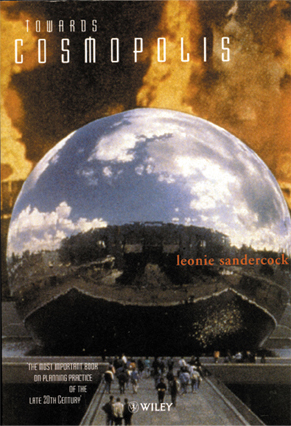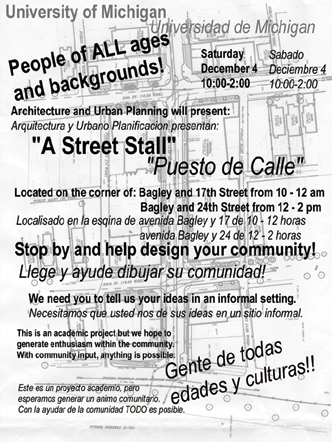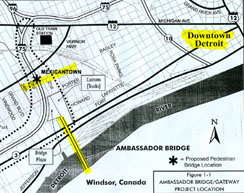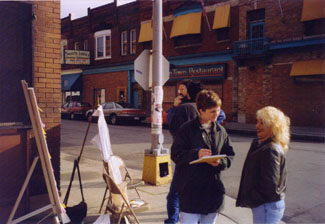Submitted by : Alok Vyas
Master of Urban Planning
Fall Semester 1999
Date: December 20, 1999
Urban Planning 631
Land Use & Physical Planning Studio
Professor Aseem Inam
University of Michigan
Let me begin by saying, why this studio turned out to be the most challenging amongst all the urban design courses I have taken at the University of Michigan. It has perfectly fitted into my list of courses for a urban design concentration. More importantly, I am very much overwhelmed by the unique experience of working with a real life community. Now, I can really call myself to have worked with a community !
I came to this university to study planning and in particular, urban design. I already have an architectural background from India, and now branching out into urban planning and design (city and regional planning) was what interested me. I thought that it would also broaden my scope of work and my marketability. I somehow wanted to influence the lives of more people than just few of my clients, and I found that planning could offer me this opportunity. I really wanted to work with the people (community) and spaces out of my buildings !
This studio has again made me reevaluate on my earlier conviction that urban design is not just about the physical space that is outside of the building, in-between buildings, in inner cities - with one. It also encompasses a variety of other metaphysical factors that deal with the social, cultural, economic, political, spiritual, physical, mental and other aspirations of the living community – the people. I realized that urban design is no longer the dominant game of just architects, planners and designers.
Introduction :
For the fall 1999 semester, Land Use & Physical Planning Studio dealt with urban design in the Mexicantown area of Southwest Detroit. Mexicantown is a small-scale representation of the issues confronting the whole of Detroit. During the course of the studio, we realized that Mexicantown was itself a debated name - some of the residents wanted to address it as Southwest Detroit, some - Hubbard Richard Citizen's District. Although the exact geographical extents of the Mexicantown were still debated from various sources, for the purpose of this design studio these were fixed from 16th Street (just off the railroad) to 24th Street across Interstate-75 in east-west direction. The north-south direction were fixed from Vernor Highway to the Ambassador Bridge.
This studio was primarily concerned with five different urban design methodologies. The product of the studio as an urban design plan was secondary. These were;
Community Based Design Methodology,
Research Based Design Methodology,
Computer Based Design Methodology,
Charrette Based Design Methodology, and
Game Based Design Methodology
I and Susan Millman, a M.Arch. candidate in the College of Architecture decided to opt as a group for Community Based Design Methodology.
Evolution of Concepts Through Presentations and Readings :
Although I presented my final concepts using the Community Based Design Methodology, I did have the opportunity to work with Computer Based Design Methodology in the earlier part of the semester. Computer based methodology was instrumental in analyzing the presentation techniques for the studio. This methodology experimented with the different ways in which design ideas can be put forward so that they are easy to grasp by the common people – the community who can’t understand professional architectural drawings. They see their community through the human perception, through the eyes – perspectives. Computer based methodology is the easiest way to produce such – common human perspectives. Using Form-Z, I created the entire community in its closest 3D volume and presented the designs using interactive views and images. Click here to view these presentation slides together ! or alternatively click on individual slides below one at a time to compensate image loading speed.
This reinforced in me the concepts of simplicity, that the designs have to be presented in such a way that the community is easy to relate to them, and should not require any further imagination on their part. We can’t simply tell the community "Imagine that you are walking across this street at this time of the day and this is how you will see the building or the plaza". They have to SEE it to believe it.

Research Text
Community Feedback : Susan Millman discussing draft plans with Louise Alexander, Planner with Hubbard Richard Citizen's District Council - Bagley Avenue.
Old Train Station on Vernor Hwy : Providing a vantage and historical point to Mexicantown. Also shows the existing physical conditions.

Street Stall Poster : Addressing the community through Multi-lingual posters (Spanish and English).

Research Text
Community Feedback : School kids seeing our draft plans, and suggesting their views. Involvement at all levels !

Child's View : A local 6 year old's impression of how she wants her neighbourhood to be like.
Gateway Plan : Federal transportation improvement plan which will facilitate easy border traffic which is pro-Ambassador Bridge company. I-75 has divided Mexicantown into two parts.
Evolution of Understanding from Research, Site Conditions of Bagley Avenue and Interaction with Community Group. Linkages of Community to Transportation Planning
My continued research with books – Towards Cosmopolis, Community Design Primer, etc sowed the seeds of community based design methodology. Even though this was much of a book-knowledge, it presented me with the problems associated with Multi-cultural societies, the voices of the borderlands and minorities (Mexican population at Bagley). The readings brought out the notion that conflicts within communities is a normal and that we as community planners have to recognize and work around them. We as planners should be always ready to listen. The research book instilled in me what are the various ways to achieve community feedback ranging from personal understanding to group meetings and personal interviews to street stalls
Bagley Avenue in Southwest Detroit had the perfect setting to test what we learnt in the research books – Multicultural society of Mexicans, their deep-seated cultural conflicts with other resident population, etc. It produced a real life community with its own real life problems.
Together with Community Planning, this was an excellent opportunity to practice Transportation Planning as well. Mexicantown has had its inherent problems dated years ago when Interstate -75 was designed by bifurcating the community into two halves. This created both, physical and economic imbalances into the community - which is so clearly evident today. The East side is relatively prosperous - attracting a greater flow of visitors due to its majority of Mexican restaurants and shops. It has far greater vibrancy with the concentration of the shops along East Bagley Avenue. West Mexicantown on the other hand presents a gloomy picture, with run-down houses, dirty streets, empty lots (even if they were bought over by the Bridge Company) and negligible human activity.
Transportation planning started with analyzing the traffic flow, of trucks and trailers that used the Ambassador Bridge to between United States and Canada. They created serious physical and environmental hazard to Mexicantown residents. We met with the community as well as Bridge Company officials and critically analyzed the Michigan Department of Transportation's proposed Gateway Plan. The analysis consisted of observing traffic counts, frequency of truck passings, studying entrance and exit routes. We came with recommendations that improvised on the Gateway Plan - erecting walls and tree (green) barriers. These walls would serve as the canvas for Mexican arts as well as grafitti. Other recommendations consisted of simplyfing entrances and exits as well as discussing the possibility of creating an underground parking bay structure for trucks that presently waited and clogged the I-75 exit.
I have to admit that, before the start of the Bagley Avenue urban design plan, my impression of the community based design was of an easy and progressive one. I thought that the community would welcome us and would be more than willing to tell us their problems and conflicts – after all who wouldn’t be able to speak about their problems ? I thought that we would easily be able to catch the nerve of the community. In short, I had taken the community for granted and assumed that they will give us all the help we need. I could never have been more wrong !
At few stages during the studio, I had been totally frustrated with the community planning process, so much so with the very few (or sometimes zero) turnouts to our community meetings and would make me wonder about the merits of community planning. Individual meetings had also run out of steam, as we weren’t able to contact and meet our community contacts. I distinctly remember that Tony Martinez, a local business owner, who had given us such a candid recount of the problems at the beginning, had totally vanished from the scene of or later meetings and interviews. I was equally disappointed with the fact that these community contacts would also never call back. But the research books and other readings brought back my courage to not give up and look for other ways to get their feedback. That’s when the street stall idea was generated.
This was also the time when I realized that the community groups are also humans and that they are prone to not showing up at meetings as well, and that community planners have to endure such disappointments as well. I began to respect the community rather than taking them for granted (automatically assuming that they will be present at the meetings). We also ran into some members who had absolutely no idea of what they wanted to see come up in their community. We had to force them into thinking for their community, including asking them questions and getting the answers out of them.
Strengths and Weakness of Methodology
There have definitely been strength and weakness of this community Based Methodology. One weakness of the methodology is the Student Project itself. The moment we mentioned that it’s a student project, we lost a lot of sincere interest from the community. They kept on asking us whether anything and how soon would the results be seen. They told us that they were tired of seeing so many student projects come and go by that they considered their involvement a futile exercise. They began to think that the student projects are just another exercise that benefited us – the students, and that the conditions would continue to be the same as they had been for the last 20-25 years.
The other significant student weakness was the student involvement on our part, in terms of time. I feel that this opportunity deserves much more of a serious involvement on our part than just a studio problem. It had been difficult at times to maintain concentration in this intensive design studio in the midst of other classes and courses. This methodology requires a lot of concentration and continuous thought process and I would have definitely would have preferred to concentrate fully on this studio capstone project as a part of a larger single directed study.
The most obvious strength is the real life exposure to community planning itself. It needed us to go out in search to form our group of community members. I personally experienced that we as planners need to identify our core members more stringently to those who are willing to be with us throughout the process. Everyone cannot be brought under the purview of this core group.
Street Stall at Site : Local residents and visitors to mexican shops and restaurants give us their feedback by writing post-it notes. Stall on East side of Bagley Avenue/I-75
Street Stall at Site : West of Bagley Avenue/I-75. Susan and I are interviewing locals and visitors and recording their observations. They also wrote on the boards.
How Could We Refine the Methodology, Given the Opportunity ?
Lastly, I would like to briefly touch upon the scope of further strengthening this community based methodology. If I had the opportunity to continue the present work, the first task would be go and physically be a part of the community. It would be vital to me to be living in the community, present at all times and ready to meet my members. It is also necessary for planners to live and note the daily events of the community. I think that it would definitely have made a big difference to live and be a part of the community for at least the duration of the studio. Such planning initiatives take time and they start by first gaining the confidence of the community by living amongst them. We have to realize the importance of communication, that for communities to work, there needs to be an effective and continuous presence of the communication medium – us as community planners. We have to offer our professional and discretionary training in planning for the benefit of the community, making them think about their priorities, about which of their concerns they would want to be addressed ? Communities would be unable to progress in the absence of a defined direction, which us planners must help identify.







